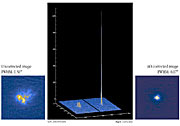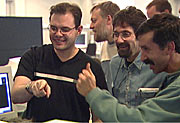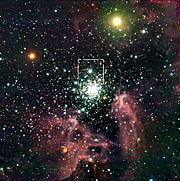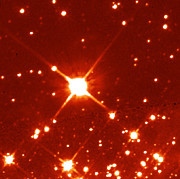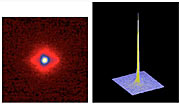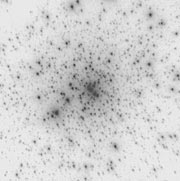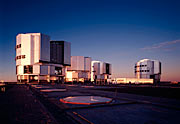Nota de prensa
Sharpest Ever VLT Images at NAOS-CONICA "First Light"
Very Promising Start-Up of New Adaptive Optics Instrument at Paranal
3 de Diciembre de 2001
A team of astronomers and engineers from French and German research institutes and ESO at the Paranal Observatory is celebrating the successful accomplishment of "First Light" for the NAOS-CONICA Adaptive Optics facility. With this event, another important milestone for the Very Large Telescope (VLT) project has been passed.
Normally, the achievable image sharpness of a ground-based telescope is limited by the effect of atmospheric turbulence. However, with the Adaptive Optics (AO) technique, this drawback can be overcome and the telescope produces images that are at the theoretical limit, i.e., as sharp as if it were in space.
Adaptive Optics works by means of a computer-controlled, flexible mirror that counteracts the image distortion induced by atmospheric turbulence in real time. The larger the main mirror of the telescope is, and the shorter the wavelength of the observed light, the sharper will be the images recorded.
During a preceding four-week period of hard and concentrated work, the expert team assembled and installed this major astronomical instrument at the 8.2-m VLT YEPUN Unit Telescope (UT4). On November 25, 2001, following careful adjustments of this complex apparatus, a steady stream of photons from a southern star bounced off the computer-controlled deformable mirror inside NAOS and proceeded to form in CONICA the sharpest image produced so far by one of the VLT telescopes.
With a core angular diameter of only 0.07 arcsec, this image is near the theoretical limit possible for a telescope of this size and at the infrared wavelength used for this demonstration (the K-band at 2.2 µm). Subsequent tests reached the spectacular performance of 0.04 arcsec in the J-band (wavelength 1.2 µm).
"I am proud of this impressive achievement", says ESO Director General Catherine Cesarsky. "It shows the true potential of European science and technology and it provides a fine demonstration of the value of international collaboration. ESO and its partner institutes and companies in France and Germany have worked a long time towards this goal - with the first, extremely promising results, we shall soon be able to offer a new and fully tuned instrument to our wide research community".
The NAOS adaptive optics corrector was built, under an ESO contract, by Office National d'Etudes et de Recherches Aérospatiales (ONERA), Laboratoire d'Astrophysique de Grenoble (LAOG) and the DESPA and DASGAL laboratories of the Observatoire de Paris in France, in collaboration with ESO. The CONICA infra-red camera was built, under an ESO contract, by the Max-Planck-Institut für Astronomie (MPIA) (Heidelberg) and the Max-Planck Institut für Extraterrestrische Physik (MPE) (Garching) in Germany, in collaboration with ESO.
The present event happens less than four weeks after "First Fringes" were achieved for the VLT Interferometer (VLTI) with two of the 8.2-metre Unit Telescopes. No wonder that a spirit of great enthusiasm reigns at Paranal!
A very special moment at Paranal!
The numerous boxes with the many NAOS and CONICA parts arrived at the ESO Paranal Observatory on October 24, 2001. Astronomers and engineers from ESO and the participating institutes and organisations then began the painstaking assembly of these very complex instruments on one of the Nasmyth platforms on the fourth VLT 8.2-metre Unit Telescope, YEPUN .
Then followed days of technical tests and adjustments, working around the clock. In the afternoon of Sunday, November 25, the team finally declared the instrument fit to attempt its "First Light" observation. The YEPUN dome was opened at sunset and a small, rather apprehensive group gathered in the VLT Control Room, peering intensively at the computer screens over the shoulders of their colleagues, the telescope and instrument operators.
Time passed imperceptibly to those present, as the basic calibrations required at this early stage to bring NAOS-CONICA to full operational state were successfully completed. Everybody sensed the special moment approaching when, finally, the telescope operator pushed a button and the giant telescope started to turn smoothly towards the first test object, an otherwise undistinguished star in our Milky Way. Its non-corrected infra-red image was recorded by the CONICA detector array and soon appeared on the computer screen. It was already very good by astronomical standards, with a diameter of only 0.50 arsec (FWHM), c.f. ESO Press Photo eso0137 (left).
Then, by another command, the instrument operator switched on the NAOS adaptive optics system, thereby "closing the loop" for the first time on a sky field, by using that ordinary star as a reference light source to measure the atmospheric turbulence. Obediently, the deformable mirror in NAOS began to follow the "orders" that were issued 500 times per second by its powerful control computer....
As if by magics, that stellar image on the computer screen pulled itself together....! What seconds before had been a jumping, rather blurry patch of light suddenly became a rock-steady, razor-sharp and brilliant spot of light. The entire room burst into applause - there were happy faces and smiles all over, and then the operator announced the measured image diameter - a truly impressive 0.068 arcsec, already at this first try, c.f. ESO Press Photo eso0137 (right)! All the team members who were lucky to be there sent a special thought to those many others who had also put in over four years' hard and dedicated work to make this event a reality.
The time of this historical moment was November 25, 2001, 23:00 Chilean time (November 26, 2001, 02:00 am UT).
During this and the following nights, more images were made of astronomcal objects, opening a new chapter of the long tradition of Adaptive Optics at ESO. More information about the NAOS-CONICA international collaboration, technical details about this instrument and its special advantages are available below.
The star-forming region around NGC 3603
Among the first images to be obtained of astronomical objects was one of the stellar cluster NGC 3603 that is located in the Carina spiral arm in the Milky Way at a distance of about 20,000 light-years, c.f. ESO Press Photo eso0137. With its central starburst cluster, it is one of the densest and most massive star forming regions in our Galaxy. Some of the most massive stars - with masses up to 120 times the mass of our Sun - can be found in this cluster.
For a long time astronomers have suspected that the formation of low-mass stars is suppressed by the presence of high-mass stars, but two years ago, stars with masses as low as 10% of the mass of our Sun were detected in NGC 3603 with the ISAAC multi-mode instrument at VLT ANTU. The high stellar density in this region, however, prevented the search for objects with still lower masses, so-called Brown Dwarfs.
The new, high-resolution K-band images like ESO Press Photo eso0137, obtained with NAOS-CONICA at YEPUN, now for the first time facilitate the study of the elusive class of brown dwarfs in such a starburst environment. This will, among others, offer very valuable insight into the fundamental problem about the total amount of matter that is deposited into stars in star-forming regions.
An illustration of the potential of Adaptive Optics
Normally, the achievable image sharpness of a ground-based telescope is limited by the effect of atmospheric turbulence . However, the Adaptive Optics (AO) technique overcomes this problem and when the AO instrument is optimized, the telescope produces images that are at the theoretical limit, i.e., as sharp as if it were in space . The theoretical image diameter is inversely proportional to the diameter of the main mirror of the telescope and proportional to the wavelength of the observed light. Thus, the larger the telescope and the shorter the wavelength, the sharper will be the images recorded .
To illustrate this, a comparison of the NAOS-CONICA image of NGC 3603 (ESO Press Photo eso0137) is here made with a near-infrared image obtained earlier by the Hubble Space Telescope (HST) covering the same sky area (ESO Press Photo eso0137). Both images are close to the theoretical limit ("diffraction limited"). However, the diameter of the VLT YEPUN mirror (8.2-metre) is somewhat more than three times that of that of HST (2.4-metre). This is "compensated" by the fact that the wavelength of the NAOS-CONICA image (2.2 µm) is about two-and-a-half times longer that than of the HST image (0.8 µm). The measured image diameters are therefore not too different, approx. 0.085 arcsec (HST) vrs. approx. 0.068 arcsec (VLT).
Although the exposure times are similar (300 sec for the VLT image; 400 sec for the HST image), the VLT image shows considerably fainter objects. This is partly due to the larger mirror, partly because by observing at a longer wavelength, NAOS-CONICA can detect a host of cool low-mass stars.
The Becklin-Neugebauer object and its associated nebulosity
ESO Press Photo eso0137 is a composite image of the region around the Becklin-Neugebauer object (generally refered to as "BN"). With its associated Kleinmann-Low nebula, it is located in the Orion star forming region at a distance of approx. 1500 light-years. It is the nearest high-mass star-forming complex.
The immediate vicinity of BN (the brightest star in the image) is highly dynamic with outflows and cloudlets glowing in the light of shock-excited molecular hydrogen. While many masers and outflows have been detected, the identification of their driving sources is still lacking.
Deep images in the infrared K and H bands, as well as in the light of molecular hydrogen emission were obtained with NAOS-CONICA at VLT YEPUN during the current tests. The new images facilitate the detection of fainter and smaller structures in the cloud than ever before. More details on the embedded star cluster are revealed as well.
These observations were only made possible by the infrared wavefront sensor of NAOS. The latter is a unique capability of NAOS and allows to do adaptive optics on highly embedded infrared sources, which are practically invisible at optical wavelengths.
Exploring the limits
The accompanying photos provide three examples of images obtained during specific tests where the observers pushed NAOS-CONICA towards the limits to explore the potential of the new instrument. Although, as expected, these images are not "perfect", they bear clear witness to the impressive performance, already at this early stage of the commissioning programme.
The first ESO Press Photo eso0137 shows how diffraction-limited imaging with NAOS-CONICA at a wavelength of 1.257 µm allows to view the individual components of a close double star, here the binary star GJ 263 for which the angular distance between the two stars is only 0.030 arcsec (i.e., the angle subtended by a 1 Euro coin at a distance of 160 km). Spatially resolved observations of binary stars like this one will allow the determination of orbital parameters, and ultimately of the masses of the individual binary star components.
After few days of optimisation and calibration, NAOS-CONICA was able to "close the loop" on a reference star as faint as visual magnitude 17 and to provide a fine diffraction-limited K-band image with Strehl ratio 19% under 0.6 arcsec seeing. ESO Press Photo eso0137 provides a view of this image, as seen in the recorder frame and as a 3D-profile. The exposure time was 200 seconds.
The ability to use reference stars as faint as this is an enormous asset for NAOS-CONICA - it will be first to offer this capability to non-specialist users with an instrument on an 8-10 m class telescope . This permits to access many sky fields and already get significant AO corrections, without having to wait for the artificial laser guide star now being constructed for the VLT, see below.
30 Doradus in the Large Magellanic Cloud (LMC - a satellite of our Galaxy) is the most luminous, giant HII region in the Local Group of Galaxies. It is powered by a massive star cluster with more than 100 ultra-luminous stars (of the "Wolf-Rayet"-type and O-stars). The NAOS CONICA K-band image ESO Press Photo eso0137 resolves the dense stellar core of high-mass stars at the centre of the cluster, revealing thousands of lower mass cluster members.
Due to the lack of a sufficiently bright, isolated and single reference star in this sky field, the observers used instead the bright central star complex (R136a) to generate the corrective signals to the flexible mirror, needed to compensate for the atmospheric turbulence. However, R136a is not a round object; it is strongly elongated in the "5 hour"-direction. As a result, all star images seen in this photo are slightly elongated in the same direction as R136a. Nevertheless, this is a small penalty to pay for the large improvement obtained over a direct (seeing-limited) image!
Adaptive Optics at ESO - a long tradition
"Adaptive Optics" is a modern buzzword of astronomy. It embodies the seemingly magic way by which ground-based telescopes can overcome the undesirable blurring effect of atmospheric turbulence that has plagued astronomers for centuries. With "Adaptive Optics", the images of stars and galaxies captured by these instruments are now as sharp as theoretically possible. Or, as the experts like to say, "it is as if a giant ground-based telescope is 'lifted' into space by a magic hand!" .
Adaptive Optics works by means of a computer-controlled, flexible mirror that counteracts the image distortion induced by atmospheric turbulence in real time. The concept is not new. Already in 1989, the first Adaptive Optics system ever built for Astronomy (aptly named "COME-ON") was installed on the 3.6-m telescope at the ESO La Silla Observatory, as the early fruit of a highly successful continuing collaboration between ESO and French research institutes (ONERA and Observatoire de Paris).
Ten years ago, ESO initiated an Adaptive Optics program, to serve the needs for its frontline VLT project.
In 1993, the Adaptive Optics facility (ADONIS) was offered to Europe's astronomers, as the first instrument of its kind, available for non-specialists. It is still in operation and continues to produce frontline results.
In 1997, ESO launched a collaborative effort with a French Consortium (see below) for the development of the NAOS Nasmyth Adaptive Optics System. With its associated CONICA IR high angular resolution camera, developed with a German Consortium (see below), it provides a full high angular resolution capability on the VLT at Paranal. With the successful "First Light" on November 25, 2001, this project is now about to enter into the operational phase.
The advantages of NAOS-CONICA
NAOS-CONICA belongs to a new generation of sophisticated adaptive optics (AO) devices. They have certain advantages over past systems.
In particular, NAOS is unique in being equipped with an infrared-sensitive Wavefront Sensor (WFS) that permits to look inside regions that are highly obscured by interstellar dust and therefore unobservable in visible light.
With its other WFS for visible light, NAOS should be able to achieve the highest degree of light concentration (the so-called "Strehl ratio") obtained at any existing 8-m class telescope. It also provides partially corrected images, using reference stars (see ESO Press Photo eso0137) as faint as visual magnitude 18, fainter than demonstrated so far at any other AO system at such large telescope.
A major advantage of CONICA is to offer the large format and very high image quality required to fully match NAOS' performance, as well as a variety of observing modes.
Moreover, NAOS-CONICA is the first astronomical AO instrument to be offered with a full end-to-end observing capability. It is completely integrated into the VLT dataflow system, with a seamless process from the preparation of the observations, including optimization of the instrument, to their execution at the telescope and on to automatic data quality assessment and storage in the VLT Archive.
Collaboration and Institutes
The Nasmyth Adaptive Optics System (NAOS) has been developed, with the support of INSU-CNRS, by a French Consortium in collaboration with ESO. The French consortium consists of Office National d'Etudes et de Recherches Aérospatiales (ONERA), Laboratoire d'Astrophysique de Grenoble (LAOG) and Observatoire de Paris (DESPA and DASGAL). The Project Manager is Gérard Rousset (ONERA), the Instrument Responsible is François Lacombe (Observatoire de Paris) and the Project Scientist is Anne-Marie Lagrange (Laboratoire d'Astrophysique de Grenoble).
The CONICA Near-Infrared CAmera has been developed by a German Consortium, with an extensive ESO collaboration. The Consortium consists of Max-Planck-Institut für Astronomie (MPIA) (Heidelberg) and the Max-Planck-Institut für Extraterrestrische Physik (MPE) (Garching). The Principal Investigator (PI) is Rainer Lenzen (MPIA), with Reiner Hofmann (MPE) as Co-Investigator.
Información adicional
Appendix: Technical Information about NAOS and CONICA
Once fully tested, NAOS-CONICA will provide adaptive optics assisted imaging, polarimetry and spectroscopy in the 1 - 5 µm waveband. NAOS is an adaptive optics system equipped with both visible and infrared, Shack-Hartmann type, wavefront sensors.
Provided a reference source (e.g., a star) with visual magnitude V brighter than 18 or K-magnitude brighter than 13 mag is available within 60 arcsec of the science target, NAOS-CONICA will ultimately offer diffraction limited resolution at the level of 0.030 arcsec at a wavelength of 1 µm, albeit with a large halo around the image core for the faint end of the reference source brightness. This may be compared with VLT median seeing images of 0.65 arcsec at a wavelength of 1 µm and exceptionally good images around 0.30 arcsec.
NAOS-CONICA is installed at Nasmyth Focus B at VLT YEPUN (UT4). In about two years' time, this instrument will benefit from a sodium Laser Guide Star (LGS) facility. The creation of an artificial guide star is then possible in any sky field of interest, thereby providing a much better sky coverage than what is possible with natural guide stars only.
NAOS is equipped with two wavefront sensors, one in the visible part of the spectrum (0.45 - 0.95 µm) and one in the infrared part (1 - 2.5 µm); both are based on the Shack-Hartmann principle. The maximum correction frequency is about 500 Hz. There are 185 deformable mirror actuators plus a tip-tilt mirror correction. Together, they should permit to obtain a high Strehl ratio in the K-band (2.2 µm), up to 70%, depending on the actual seeing and waveband.
Both the visible and IR wavefront sensors (WFS) have been optimized to provide AO correction for faint objects/stars. The visible WFS provides a low-order correction for objects as faint as visual magnitude ~ 18. The IR WFS will provide a low-order correction for objects as faint as K-magnitude 13.
CONICA is a high performant instrument in terms of image quality and detector sensitivity. It has been designed so that it is able to make optimal use of the AO system. Inherent mechanical flexures are corrected on-line by NAOS through a pointing model. It offers a variety of modes, e.g., direct imaging, polarimetry, slit spectroscopy, coronagraphy and spectro-imaging
Information for the media: ESO is producing a Video News Release (ESO Video News Reel No. 13) with sequences from the NAOS-CONICA "First Light" event at Paranal, a computer animation illustrating the principle of adaptive optics in NAOS-CONICA, as well as the first astronomical images obtained. In addition to the usual distribution, this VNR will also be transmitted via satellite Friday 7 December 2001 from 09:00 to 09:15 CET (10:00 to 10:15 UT) on "Europe by Satellite" . These video images may be used free of charge by broadcasters. Satellite details, the script and the shotlist will be on-line from 6 December on the ESA TV Service Website http://television.esa.int. Also a pre-view Real Video Stream of the video news release will be available as of that date from this URL.
Contactos
Norbert Hubin
ESO
Garching, Germany
Tlf.: +4989-3200-6517
Email: nhubin@eso.org
Alan Moorwood
ESO
Garching, Germany
Tlf.: +4989-3200-6294
Email: amoorwoo@eso.org
Acerca de la nota de prensa
| Nota de prensa No.: | eso0137 |
| Legacy ID: | PR 25/01 |
| Nombre: | 30 Doradus, Adaptive Optics, Becklin-Neugebauer Object, First Light, Instrumentation, NGC 3603, R136a, Very Large Telescope |
| Tipo: | Unspecified : Technology : Observatory : Instrument |
| Facility: | Very Large Telescope |
| Instruments: | NACO |

